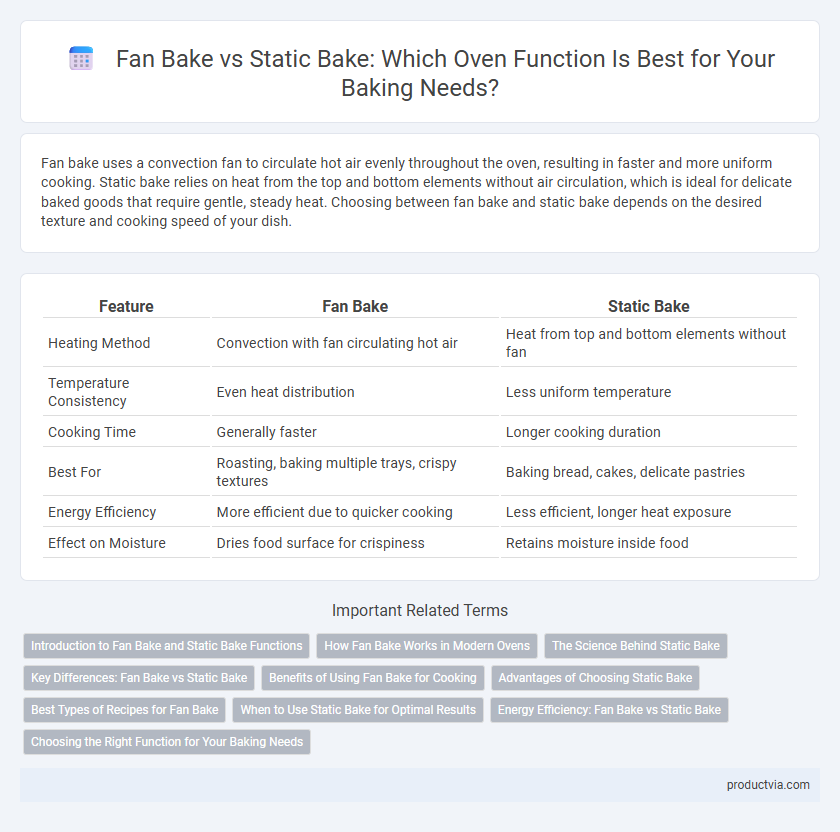Fan bake uses a convection fan to circulate hot air evenly throughout the oven, resulting in faster and more uniform cooking. Static bake relies on heat from the top and bottom elements without air circulation, which is ideal for delicate baked goods that require gentle, steady heat. Choosing between fan bake and static bake depends on the desired texture and cooking speed of your dish.
Table of Comparison
| Feature | Fan Bake | Static Bake |
|---|---|---|
| Heating Method | Convection with fan circulating hot air | Heat from top and bottom elements without fan |
| Temperature Consistency | Even heat distribution | Less uniform temperature |
| Cooking Time | Generally faster | Longer cooking duration |
| Best For | Roasting, baking multiple trays, crispy textures | Baking bread, cakes, delicate pastries |
| Energy Efficiency | More efficient due to quicker cooking | Less efficient, longer heat exposure |
| Effect on Moisture | Dries food surface for crispiness | Retains moisture inside food |
Introduction to Fan Bake and Static Bake Functions
Fan bake in ovens utilizes a built-in fan to circulate hot air evenly around the food, promoting faster and more uniform cooking, ideal for roasting and baking multiple dishes simultaneously. Static bake relies on heat from the top and bottom heating elements without air circulation, suitable for traditional baking tasks such as cakes and bread where steady, even heat is essential. Choosing between fan bake and static bake depends on the desired texture and cooking speed, with fan bake providing a quicker, crispier finish and static bake ensuring gentle, consistent heat.
How Fan Bake Works in Modern Ovens
Fan Bake in modern ovens uses a built-in fan to circulate hot air evenly throughout the oven cavity, promoting uniform cooking and reducing hot spots. This convection method accelerates heat transfer, leading to faster cooking times and more consistent browning compared to static bake, which relies solely on heat from the top and bottom elements without air circulation. Fan Bake is ideal for roasting meats and baking multiple trays simultaneously due to its efficient temperature distribution.
The Science Behind Static Bake
Static bake in ovens utilizes radiant heat from the top and bottom heating elements, creating a stable temperature environment that promotes even cooking without air circulation. This method is ideal for baking delicate items like bread and pastries, where moisture retention and texture are crucial. The absence of fan-driven airflow prevents drying out the surface, allowing for a more uniform rise and a crisp, golden crust.
Key Differences: Fan Bake vs Static Bake
Fan Bake circulates hot air evenly throughout the oven cavity using a built-in fan, promoting faster and more uniform cooking, especially ideal for roasting and baking multiple trays simultaneously. Static Bake relies on heat radiating from the top and bottom heating elements without air circulation, offering a gentler cooking environment best suited for delicate baked goods like souffles and custards. Fan Bake enhances browning and crispiness while Static Bake provides consistent heat that's essential for recipes requiring precise texture control.
Benefits of Using Fan Bake for Cooking
Fan Bake uses a convection fan to circulate hot air evenly throughout the oven, resulting in faster and more consistent cooking times compared to static bake. This method enhances browning and crisping of foods by promoting uniform heat distribution, which is ideal for roasting meats and baking pastries. Energy efficiency is improved as the oven temperature can often be set lower while achieving the same cooking results, reducing overall cooking time and power consumption.
Advantages of Choosing Static Bake
Static bake offers precise, even heat distribution by using only the oven's top and bottom heating elements without fan circulation, preserving the natural moisture of baked goods. This function is ideal for delicate items like cakes and custards, preventing excessive drying and ensuring tender textures. Choosing static bake enhances traditional baking results by maintaining consistent temperature and texture integrity.
Best Types of Recipes for Fan Bake
Fan Bake mode in ovens circulates hot air evenly, making it ideal for recipes requiring consistent heat such as roasted vegetables, baked goods like cookies and pastries, and multi-rack baking. This function enhances browning and crisping, delivering uniform cooking results without hot spots. Fan Bake is particularly effective for recipes that benefit from faster cooking and a crisp exterior, including casseroles and roasting meats.
When to Use Static Bake for Optimal Results
Static bake is ideal for delicate dishes such as custards, souffles, or baked goods requiring gentle heat without air circulation to prevent drying or uneven rising. Use static bake when roasting meats or slow-cooking casseroles to achieve tender textures and well-developed flavors through consistent, radiant heat. This method also suits recipes that benefit from browning on the surface without drying out the interior, ensuring optimal moisture retention.
Energy Efficiency: Fan Bake vs Static Bake
Fan bake uses a convection fan to circulate hot air evenly, reducing cooking time and lowering energy consumption compared to static bake. Static bake relies on radiant heat from the oven's elements without air circulation, often leading to longer cooking times and higher energy use. Choosing fan bake technology can increase oven energy efficiency by up to 20%, making it a more cost-effective option for consistent baking results.
Choosing the Right Function for Your Baking Needs
Fan bake circulates hot air evenly, reducing cooking time and providing a crispier texture, ideal for roasting meats and baking multiple trays simultaneously. Static bake uses natural heat from the top and bottom elements, offering gentle, consistent temperatures perfect for delicate cakes, custards, and bread. Choosing the right function depends on your recipe requirements, with fan bake suited for faster, even cooking and static bake preferred for traditional baking results.
Fan Bake vs Static Bake for Oven Function Infographic

 productvia.com
productvia.com